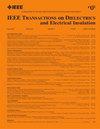Breakdown Characteristics and Damage Mechanism of Typical Defects in Oil-Paper Insulation Under HEMP
IF 2.9
3区 工程技术
Q2 ENGINEERING, ELECTRICAL & ELECTRONIC
IEEE Transactions on Dielectrics and Electrical Insulation
Pub Date : 2024-10-11
DOI:10.1109/TDEI.2024.3479129
引用次数: 0
Abstract
High-altitude electromagnetic pulses (HEMPs) can couple with power transmission and distribution lines, creating a nanosecond-level HEMP conductive environment that can degrade the insulation performance and even cause breakdown of distribution transformers, posing a threat to the safe operation of power systems. In this article, based on the main vulnerable parts identified in HEMP effect tests on distribution transformers, a typical defect model of oil-paper insulation was constructed, and an experimental platform was set up to study the breakdown characteristics of oil-paper insulation under HEMP. The process of charge accumulation was analyzed using finite element simulation, revealing the damage mechanism of oil-paper insulation under HEMP and other nanosecond pulses. The results show that the breakdown characteristics of oil-paper insulation under HEMP have a significant polarity effect, which is related to the accumulation of charges at the interface of oil-paper insulation. The accumulation of charges at the interface of oil-paper insulation is comparable to the nanosecond rise time of the HEMP waveform, resulting in a certain balance relationship in the location of breakdown points. Under negative-polarity HEMP, needle-plate defect structures have a higher proportion of breakdown at the trailing edge of the waveform, indicating that the energy provided within the rise time of the HEMP waveform is slightly insufficient.HEMP下油纸绝缘典型缺陷击穿特性及损伤机理
高空电磁脉冲(HEMPs)会与输配电线路耦合,产生纳秒级的HEMP导电环境,会降低配电变压器的绝缘性能,甚至导致配电变压器击穿,对电力系统的安全运行构成威胁。本文在对配电变压器进行HEMP效应试验中确定的主要易损件的基础上,建立了油纸绝缘的典型缺陷模型,搭建了实验平台,研究了HEMP作用下油纸绝缘的击穿特性。利用有限元模拟分析了电荷积累过程,揭示了麻麻和其他纳秒脉冲作用下油纸绝缘的损伤机理。结果表明:在HEMP作用下,油纸绝缘击穿特性具有显著的极性效应,这与油纸绝缘界面电荷的积累有关。油纸绝缘界面电荷的积累与HEMP波形的纳秒级上升时间相当,导致击穿点位置存在一定的平衡关系。负极性HEMP下,针板缺陷结构在波形尾缘击穿比例较高,说明在HEMP波形上升时间内提供的能量略不足。
本文章由计算机程序翻译,如有差异,请以英文原文为准。
求助全文
约1分钟内获得全文
求助全文
来源期刊
CiteScore
6.00
自引率
22.60%
发文量
309
审稿时长
5.2 months
期刊介绍:
Topics that are concerned with dielectric phenomena and measurements, with development and characterization of gaseous, vacuum, liquid and solid electrical insulating materials and systems; and with utilization of these materials in circuits and systems under condition of use.

 求助内容:
求助内容: 应助结果提醒方式:
应助结果提醒方式:


